
Monday March 13, 2006
New Sloter Ferrari 312 PB "LongTail"
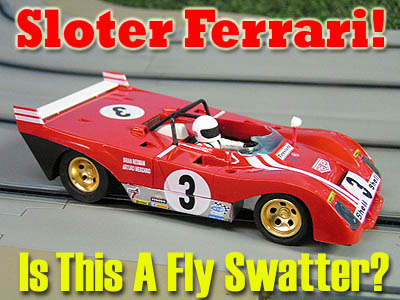 One
of the newest faces in the ready to run 1/32nd scale arena has so far achieved
praise from many enthusiasts. Sloter is a relatively new company that seems
intent on bringing us even more classic muscle with several new offerings. When
this model finally arrived on our shores it did not take long for one to
eventually find it's way here. Would this car have what it takes to compete with
my Fly Classics? Read on and find out!
One
of the newest faces in the ready to run 1/32nd scale arena has so far achieved
praise from many enthusiasts. Sloter is a relatively new company that seems
intent on bringing us even more classic muscle with several new offerings. When
this model finally arrived on our shores it did not take long for one to
eventually find it's way here. Would this car have what it takes to compete with
my Fly Classics? Read on and find out!
If there is a series of road racing cars in my collection that see more time than any other, it is the classic line by Fly Car Model. We enjoy how they perform (although they need work) and my collection has grown to embarrassing numbers over the last few years. Sloter seems to be directly challenging this long time series and I could not wait to see one in person.


Coming in a very simple cardboard box, I was very impressed with the car as soon as I seen it. Overall fit and finish of this classic is very well done. All the markings on my model were crisp and opaque with no runs or fades. A very clean and even clear-coat seals and protects things nicely and you can almost see a country mile in the Ferrari red of the body. I did notice some of the mold lines on the sides of the body were a little more pronounced and could detect some slight amount of uneven surface near the fender wells. It is not a glaring issue, but for those who look for items like this it is present. The mirror which is very fragile is molded in white and the shaft is hand painted red. It is not the same shade of red and they could have paid a little more attention to making it not only match the body, but to paint the entire shaft.

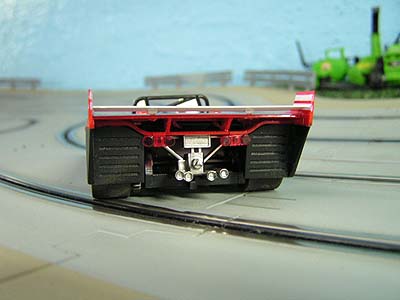
There have been some fine scale enthusiasts that have found some slight issues with the model, but as far as I can tell, Sloter has done a decent job of reproducing it in scale. These cars and variations of it seen plenty of action in 1972 and I was very pleased that Sloter chose to bring us this version. However, there is more (or less?) to this fine classic than meets the eye.
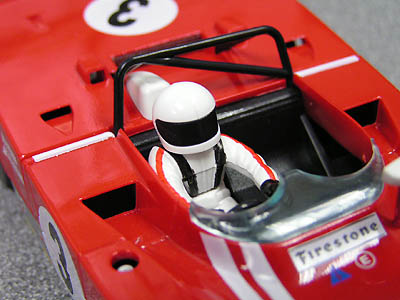
I quickly directed my attention to the wheels and tires. They seemed to have done a decent job in the scale department, but were they going to be round and true, or perhaps need the usual work on them? I looked at the tires and although the compound seems very soft they had a very noticeable crown to them. Both front and rears had these low centers and I began to think the worst.
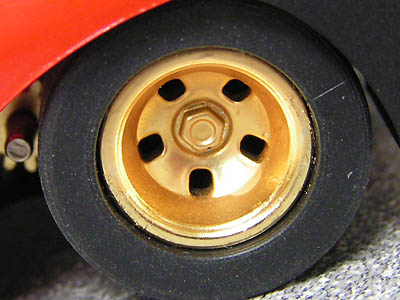
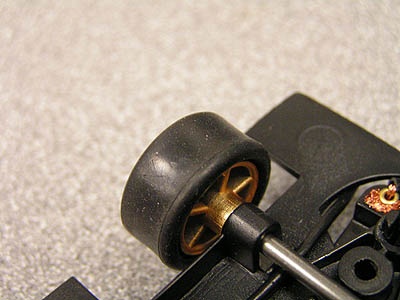
One very important trait of these models is that they do NOT come equipped with a magnet. There is a pocket available in the chassis for you to add one if you wish, but it seemed obvious that it was intended to race without it. It was time for me to see just how badly it would run out of the box with the tires in the condition that they were and without a magnet to help disguise any other issues.
And since it was non-magnet, why not test this model on our new wood track? The latest bullring oval by AutoRama is as flat and smooth as any wood track I have seen or raced on. It has already shown itself to be unforgiving to any model that attempts to run on it with even the slightest tire, axle, or wheel issues. If there was anything wrong on this model, it would soon show itself.
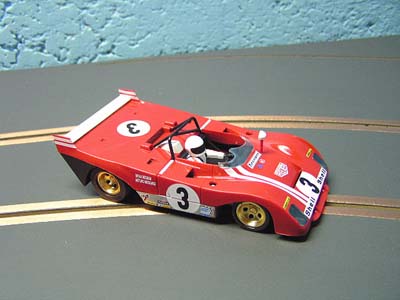
But the very first laps it ran made me form new opinions...and quickly. Even though these tires do have this crown, they are as round and true as you could ask for. The model was just incredibly smooth and it simply glided through the turns. Another thing that surprised me was the grip level of these tires. Barely half of the tires were actually making contact with the track, yet the grip they produced made it obvious these tires could be excellent performers.
The bad news was that this car would de-slot much too easily when you applied the throttle. Almost every test I did seen the front end hop out of the slot. As smooth as this car was, my first impressions were that we needed a ton of weight up front to set things right. Time would tell later on in our testing.
As good as the model drove out of the box, I soon discovered an issue that just might cause problems. While taking photos of the model I noticed that the rear of the chassis was bent or appeared to be. It was clear that the body was not sitting even on the chassis so I decided to get inside to take a closer look.
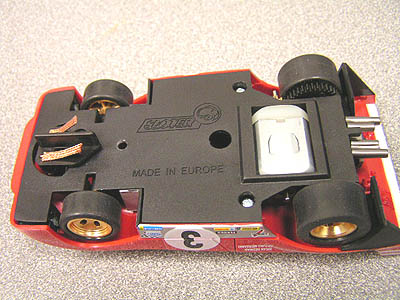
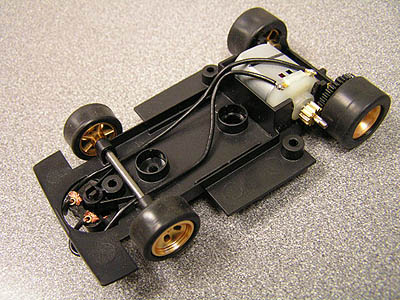
There are 3 screws that mount the body to the chassis with the front screw accessible through a hole in the front guide. I thought this was a nice feature and commend Sloter on this.
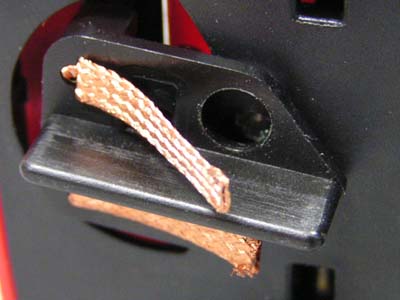
Inside we see the extra magnet pockets as well as the motor which appears to be identical to Fly and other Mabuchi motors. I do not have any RPM ratings on it but perhaps we will know soon. As soon as I removed the body I began to inspect the rear of the model. The photos may not show it clearly, but it seems on my chassis there is some visible unevenness to the rear of the chassis and rear axle assembly.
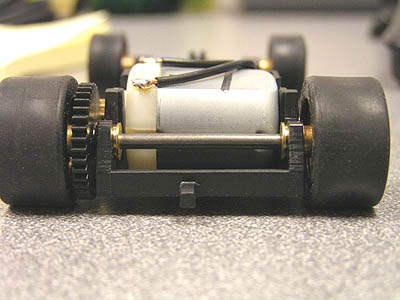
The chassis sits level on a flat surface and all 4 wheels had perfect contact which explained why the car ran so well out of the box. It appears that when they molded this chassis that the bottom left hand side of the of the chassis was either not designed correctly or it simply did not come out of the mold properly.

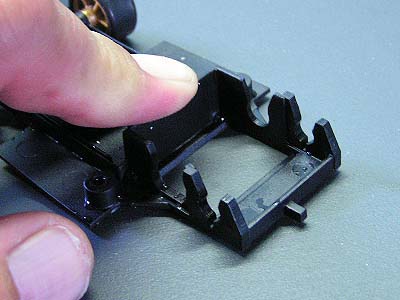
I tried to remove the rear axle and heat the chassis with hot water to try and bring the left side axle mount up where it should be. I first removed the motor and rear axle and placed the chassis under very hot tap water for about 30 seconds and then removed it and placed it on my countertop. Since the amount of the bend was so much, instead of just placing a couple heavy books over it, I added pressure to the chassis by hand for around a minute. This did help eliminate most of it, and although I liked the results there was now a potential new issue: tire rub.
Now that the chassis was a more even fit, it would cause the left tire to rub under load. It was clear that some light body trimming was in order to at least allow the model to function without tire to body contact. However, I knew the tires needed a large amount of sanding to get them true, so before I did any body trimming I sanded the tires instead. Sanding cured the tire rub issue so modifying the chassis was not needed.
I noticed during tire sanding that one of the rear bushings was spinning in the chassis mount. A quick drop of adhesive on each bushing cured this problem.
The model now had a much better look to it and the chassis was free of any bends. I double-checked it on my set-up block to make sure I had it where I thought it should be and it was now time to test it again.
More Performance?
The Sloter model differs from Fly as it comes equipped with a 12 tooth pinion 35 tooth crown (2.917 ratio) instead of the more common 11 to 36 (3.273). It was time to see if this would have any real effects on our medium sized Dixon Hills Speedway. It also comes with a solid front axle that many enthusiasts like to change to in Fly Classics. I started the duel by adding a Fly standard button magnet in the rear pocket. The photo shows you can put another magnet up front if you wish, and it appears from the whole in the chassis that it might be ready for digital as well.
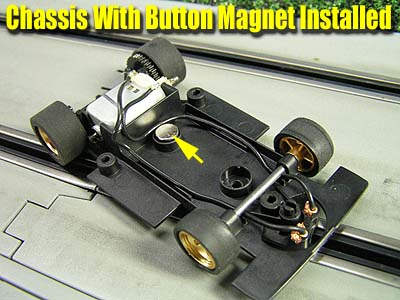
With only one magnet in place and the tires heavily sanded to make them true, it was time to see if this car could keep pace with the small Porsche I chose as its adversary. After only a few laps I noticed that the front end was very light and that although it does have a decent sized guide to it, it would come out of the slot a little too easily for my tastes. With having to drive the car with a little less aggression in the corners, my best lap time was a 4.288. The Porsche quickly bested that with a 3.978 run.
Looking at the front end I noticed that the front tires were holding more weight and that the car was not quite a perfect tri-pod. It clearly needed the front tires sanded to get them concentric and to stop the wheel hop that was aiding my de-slotting woes. First however I had to check the wheel itself. Sure enough there was flash molding present on the wheel that needed to be cleaned off before I could sand the tires cleanly.
I removed the front axle by twisting one of the wheels off and then mounted the axle with one wheel still attached in my Dremel. I removed the tire and using fine grit sandpaper I turned the Dremel on the lowest setting and quickly had the wheel free of any flash molding and in turn it trued the wheel. I then mounted the tire and using medium grit sandpaper I held the tire against it and sanded it until the high edges were gone and the tire was completely true.

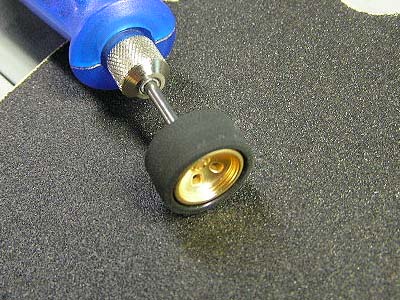
Then I removed this tire and replaced it with the other one and performed the procedure again. Now I removed this wheel from the axle and replaced it with the other wheel and sanded it clean of any and all flash molding. I re-mounted the tire and wheel and re-assembled it back into the chassis. Hopefully we have cured our de-slotting woes, or at least decreased them.
And the results were favorable. I immediately noticed I could drive deeper into the corners and accelerate out with more power. It was still a little light in the front but things were smooth as silk. Although I was pleased, the best time I could post was a 4.105 These times are decent and against other models such as the recent Porsche 917LH and Ferrari LongTail it was a dominant model. But against a car that had nearly the same length and weight, (Porsche was 70 grams, Sloter Ferrari with magnet was 64 grams) I could not get it to be as competitive as I would like.
The main culprit was the magnet distance. There was clearly a larger distance between the magnet and the rails while just looking at both models on a set-up block. I also noticed that the plastic in the Sloter chassis was slightly thicker and this too prevented the magnet from coming close to the distance found in Fly models.
Lumbering On
However, I have to be fair. Sloter released this model without the magnet and it deserved to be tested that way. I removed the magnet from both models and it was time to start our contest once again. First we would test on plastic, and then back to the AutoRama Bullring oval.
Although the car was very smooth, without the magnet helping hold it in place, the front end still jumped out of the slot much too easily. When I applied throttle lightly it was fine but even at 12 volts when I applied full throttle into the long straights, it would de-slot at least 80 percent of the time. This car needed weight and plenty of it.

I started to add small amounts up front, but it only marginally helped. I decided to cut a .050 inch thickness sheet of Slick 7 lead at 8 grams and place it under the chassis. Well, this was the hot set-up as now I could finally apply full throttle without jumping out of the slot. And with this issue solved the Sloter model left my non-magnet Porsche in the dust. I was pulling lap times in the averages of 4.3 seconds while our Porsche could only muster 4.5 averages.
I like this kind of challenge. Although many will pass on these models, sometimes the fun of this hobby is doing a little tuning to set things where you want them. If you are solo racing against the clock, this just adds an even more challenge. I was determined to make this car run smoothly and get the lap times within striking distance of the nearest competitor and I think I achieved that. Fun? Oh yeah.
Conclusions
By itself, the Sloter model is a decent slot car but like many cars today it needs work. Ironically, they are almost too similar to Fly as they have the potential to create some very nice models in the future if they apply more attention to detail in the quality control department.
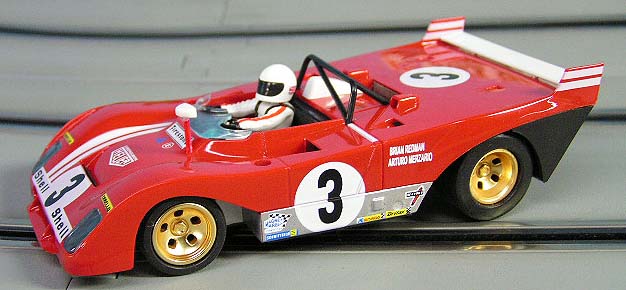
However, the amount of work I had to do is right at the level I perform on my Fly Classics and that has not stopped me from owning and enjoying them. I look forward in having more additions from Sloter in my stable as I feel they can be a very tough competitor in this class of racing. If you enjoy the tuning process, I think these models will deliver some very satisfying home racing and also compliment your current collections.
-Harry
As always feel free to contact me about this article or just the hobby in general at harry@homeracingworld.com, or better yet drop into our Message Forum and share your thoughts with other enthusiasts!
Thanks go to www.SlotCarPlace.com for providing us with this model